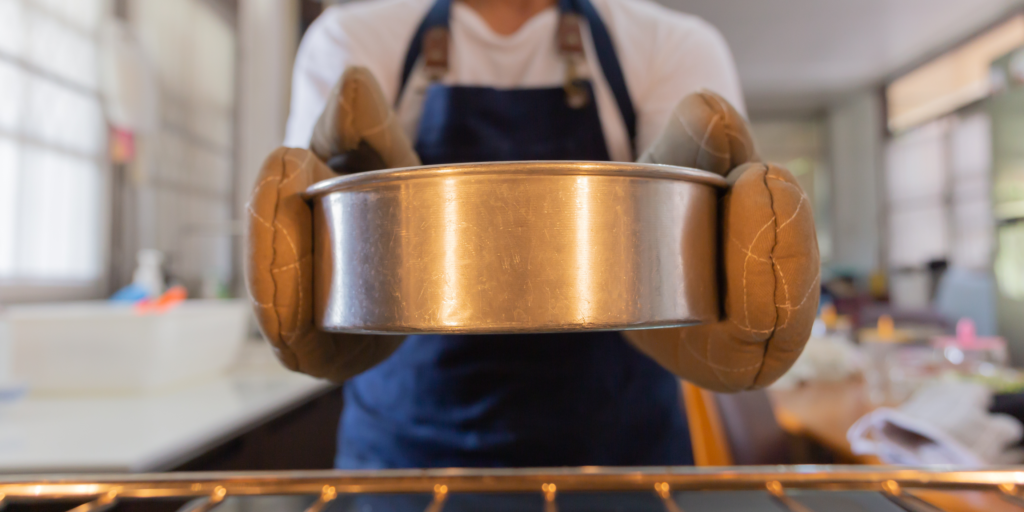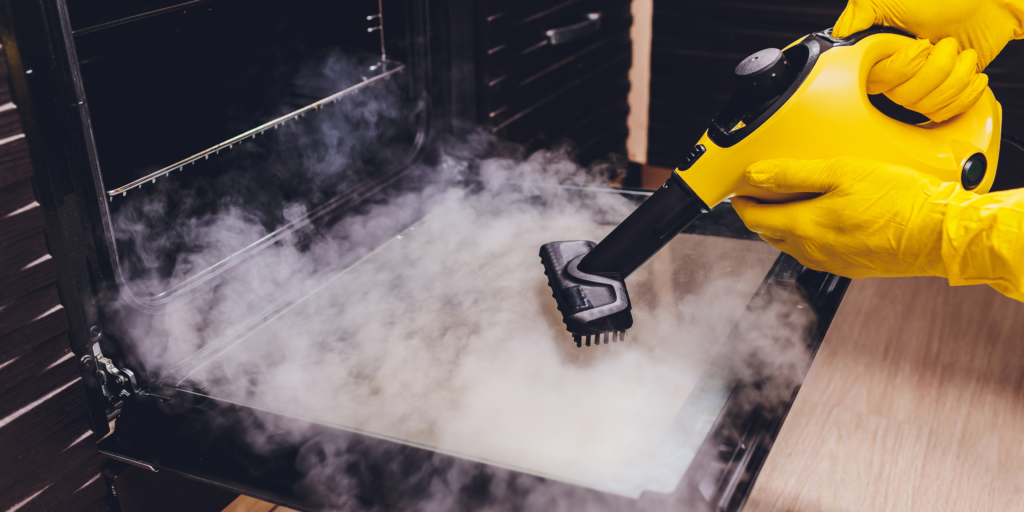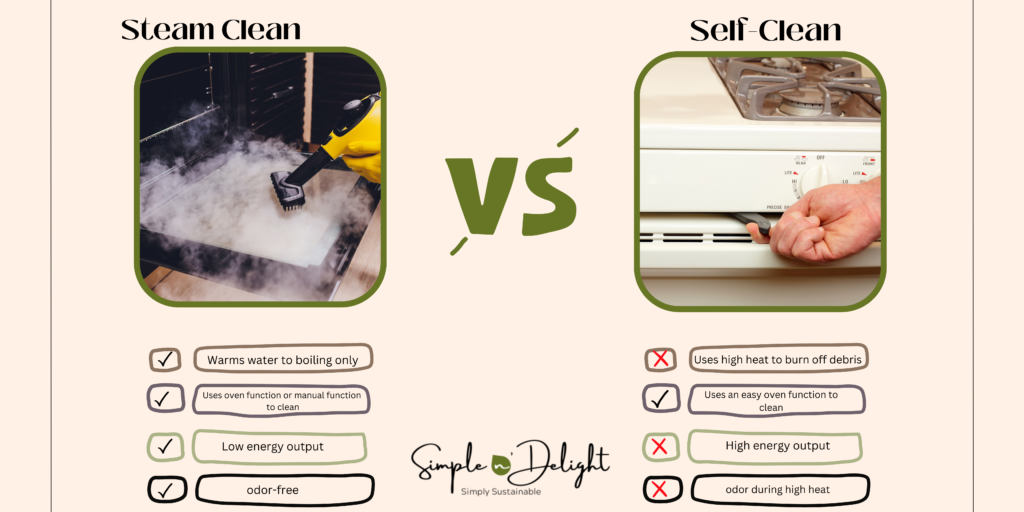Tired of wrestling with tough oven grime and worried about the harsh chemicals you’re using? Say goodbye to the old ways and welcome the new era of cleaning: steam clean an oven instead! In this comprehensive guide, we will explore three methods to achieve a spotless oven while prioritizing sustainability, health, and efficiency.
RELATED: Cooking Sustainably: Unveiling the Optimal Pots and Pans for Gas Stoves
Steam clean an Oven vs. traditional cleaning methods

Before diving into the step-by-step process, let’s compare steam cleaning with traditional cleaning methods to understand why steam cleaning is the superior choice for achieving a spotless oven.
Traditional cleaning methods usually involve the use of chemical cleaners and abrasive scrubbing. I remember cleaning my oven back in the 90’s with a heavy duty cleaner and one spot of the cleaner made its way onto my skin, burning layers of skin and flesh. This was not fun and since then I have figured out a better, safer way!
Not only are these chemicals unsafe, but these methods can be time-consuming, require significant physical effort, and may leave behind chemical residue that can be harmful if not properly rinsed off.
On the other hand, steam cleaning offers a more efficient and effective cleaning solution. The high temperature of the steam helps to break down grease and dirt, making it easier to wipe away. It reaches into tight corners and crevices, ensuring a thorough clean. Moreover, steam cleaning is gentle on the oven’s surfaces, preventing any potential damage that may occur with abrasive scrubbing.
Green Cleaning: The Advantages of Steam Cleaning an Oven

- Chemical-Free Clean: Say farewell to harsh chemicals that can be harmful to your health and the environment. Oven cleaners can cause poisoning or irritation [1] to the skin, lungs and stomach.
- Eco-Friendly Approach: By avoiding the use of chemicals and excessive water consumption, steam cleaning aligns perfectly with your eco-conscious lifestyle.
- Effortless Grease Removal: Steam’s natural properties make it an effective grease buster, reducing the need for elbow grease and saving you time.
- Gentle on Surfaces: Unlike abrasive scrubbing methods, steam cleaning is gentle on your oven’s interior, preventing potential damage.
- Hygienic Results: Steam’s high temperature not only removes grime but also sanitizes surfaces, leaving them germ-free.
- No Residue: Steam evaporates quickly, ensuring no chemical or cleaning residue remains in your oven leading to a safer over for future use.
Steam Clean an Oven-Method #1:
Utilizing the Built-In Steam Cleaning Function

Modern ovens are equipped with advanced features, and the built-in steam cleaning function is one of them. This method offers an effortless way to achieve a sparkling oven interior. Some of the modern brands incorporating steam cleaning into their appliances are:
Here’s how to do it:
1. Activate the Steam Cleaning Function: Start by selecting the steam cleaning function on your oven’s control panel. Allow the oven to reach the recommended cleaning temperature.
2. Add Water: Once the oven is heated, pour around 10oz of water into the oven’s base.
3. Close the Door: Seal the oven by closing the door, creating the ideal environment for steam to work its magic.
4. Let Steam Work: As the water transforms into steam, it will gently soften and loosen dirt, grease, and grime from the oven’s interior surfaces. This will generally take about 30 minutes.
5. Wipe Down: After the steam cleaning cycle is complete, use a cloth to wipe away the softened residues. You’ll be amazed at how effortlessly the grime comes off.
Advantages:
– Easy to use, with minimal effort required.
– Gentle on oven surfaces.
– No need for chemicals.
Steam Clean an Oven-Method #2:
The Boiling Water Approach

Don’t have a built-in steam cleaning function? No problem! You can achieve a similar effect using a simple boiling water technique. Here’s how:
1. Boil Water in an Oven-Safe Pot: Fill an oven-safe pot with water and place it in the oven. Heat the oven to around 250°F (120°C) and let the water boil for about 20-30 minutes. You may add a cup of vinegar at this point too if you find the debris to be hardened and thick.
2. Allow Cooling: Turn off the oven and let it cool down. This will allow the steam generated from the boiling water to soften the dirt and grime on the oven’s surfaces.
3. Create a Cleaning Solution: While the oven is cooling, mix a solution of equal parts white vinegar and water in a spray bottle. Add a tablespoon of baking soda to enhance the cleaning power or create a paste with the baking soda for burnt on debris.
4. Spray and Wipe: Once the oven is cool, spray the vinegar and baking soda solution on the interior surfaces. Let it sit for a few minutes, then wipe away the loosened residues with a cloth.
5. Rinse: Dampen a cloth with clean water and wipe down the oven to remove any remaining solution. Dry with a clean cloth.
Advantages:
– Effective even without a built-in steam cleaning function.
– Natural ingredients are used for cleaning.
– Budget-friendly approach.
Steam Clean an Oven-Method #3:
The Handheld Steam Cleaner

For a versatile and targeted approach, consider using a handheld steam cleaner. These multipurpose devices are designed to clean various surfaces, including ovens. Here’s how:
1. Choose the Right Attachment: Most handheld steam cleaners come with specific attachments for different cleaning tasks. Select an attachment suitable for oven cleaning.
2. Fill the Steam Cleaner: Fill the steam cleaner’s water tank according to the manufacturer’s instructions.
3. Heat Up the Steam Cleaner: Allow the steam cleaner to heat up as recommended by the manufacturer.
4. Steam and Wipe: Hold the steam cleaner attachment a few inches away from the oven’s interior surfaces and release steam. Use the attachment to scrub away loosened dirt and grime.
5. Wipe Down: Wipe away the softened residues with a cloth.
**You may wish to remove the door of your oven for easier reach. Be sure to follow the manufacturer’s instructions on how to do this for your specific oven.
Advantages:
– Targeted cleaning in hard-to-reach areas.
– Versatile tool for other cleaning tasks.
– Chemical-free cleaning.
Steam Cleaning vs. Self-Cleaning:
A Sustainable Perspective

When it comes to maintaining your oven, the debate between traditional self-cleaning methods and the innovative steam cleaning approach is worth exploring. Let’s delve into the differences and understand why steam cleaning shines through as the more sustainable choice for an effective and eco-friendly clean.
Self-Cleaning Method:
The self-cleaning function, a mainstay in many ovens, employs extreme heat to burn off food residues. While effective, it comes at a cost. High energy consumption and potential emissions of noxious odors and smoke make it a less sustainable option. Additionally, the intense heat can potentially damage oven components and coatings, shortening the appliance’s lifespan.
Steam Cleaning Method:
In contrast, steam cleaning takes a more eco-conscious route. Using the power of water vapor, steam cleaning gently but effectively loosens dirt and grime without the need for harsh chemicals or excessive heat. This not only reduces energy consumption but also ensures a safer indoor environment by avoiding the release of harmful fumes. By embracing steam cleaning over traditional self-cleaning methods, you’re actively choosing a more sustainable path.
FAQ About Steam Cleaning Your Oven

1. Can I use the steam cleaning function on my oven for regular maintenance?
Yes, the built-in steam cleaning function is designed for routine cleaning, effectively removing grease and grime from your oven’s interior. However, for heavy buildup, you may need to use additional cleaning methods.
2. How often should I steam clean my oven?
For general maintenance, steam cleaning your oven every one to two months is recommended. Adjust the frequency based on your cooking habits and the level of dirt accumulation.
3. Are there any surfaces I should avoid steam cleaning in my oven?
While steam cleaning is generally safe for oven interiors, avoid using it on electronic components or gaskets, as excessive moisture can damage these parts. Consult your oven’s manual for guidance.
4. Can I use any type of water in my handheld steam cleaner?
It’s best to use distilled or filtered water to prevent mineral buildup in your steam cleaner’s tank. Using regular tap water could lead to scaling over time.
5. Can I steam clean the oven racks and accessories too?
Yes, you can steam clean oven racks and accessories separately using the handheld steam cleaner or the built-in steam cleaning function. Follow the manufacturer’s instructions and precautions for each method.
6. Is steam cleaning safe for self-cleaning ovens?
Steam cleaning is generally safe for self-cleaning ovens. However, consult your oven’s manual to ensure compatibility and avoid any potential damage.
7. Is it necessary to wipe down the oven after steam cleaning?
Yes, wiping down the oven after steam cleaning is important to remove softened residues and prevent mold growth. A clean, dry cloth should be used for this purpose.
8. Can I use steam cleaning for the oven door and glass window?
Steam cleaning can be used on the oven door and glass window, but be cautious not to over-saturate these areas. Excessive moisture could seep into the door’s insulation and cause damage.
9. Can I steam clean immediately after cooking in the oven?
It’s recommended to wait until the oven has cooled down before steam cleaning to avoid steam burns and ensure effective cleaning.
10. Can I use steam cleaning for ovens with a non-stick coating?
Yes, steam cleaning is safe for ovens with non-stick coatings. However, avoid using abrasive cleaning attachments that could scratch the coating.
11. Does steam cleaning eliminate the need for traditional cleaning methods entirely?
While steam cleaning is highly effective, heavy buildup or stubborn stains may require a combination of methods for optimal results.
12. Can I use essential oils or fragrances in my steam cleaner for a pleasant aroma?
It’s not recommended to add essential oils or fragrances to your steam cleaner, as they can clog the machine or leave behind residues. Stick to using only water for steam generation.
13. How do I steam clean my Samsung oven?
To use the steam clean function on a Samsung oven, start by ensuring your oven is empty. Activate the steam cleaning mode through the control panel and add about 10oz of water to the designated reservoir. Close the door, follow the prompts on the display to start the cycle, wait for it to complete, then wipe down the interior to reveal a refreshed and clean oven.
Feel free to reach out if you have more questions or need further guidance on steam cleaning your oven!
Conclusion: Embrace Sustainable Living with Steam Cleaning
As we bid farewell to the traditional, chemical-laden ways of oven cleaning, we usher in a new era of sustainable living through steam cleaning. By choosing to harness the power of steam, you’re making a conscious decision to prioritize both the health of your home and the well-being of our planet.
In a world where every action counts, the choice to use steam cleaning methods resonates with eco-conscious values. The advantages of chemical-free, efficient, and gentle cleaning not only ensure a healthier environment for you and your loved ones but also contribute to the collective efforts of preserving our planet for future generations.
Whether you’re utilizing your Samsung oven’s built-in steam cleaning function, adopting the boiling water approach, or embracing a handheld steam cleaner, each step you take echoes the principles of sustainable living. With a sparkling and rejuvenated oven, you’re not only transforming your kitchen but actively participating in a cleaner, greener world—one steam-cleaning session at a time.








One Response
Wait – what the heck! I had NO IDEA there was a steam-cleaning feature in my oven. Guess what I’m doing right now? Thank you for the tips! A game changer.